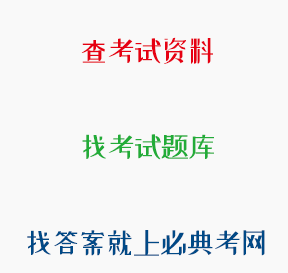正确答案: D
60分钟
题目:关于我国《国家中长期教育改革和发展规划纲要(2010-2020年)》针对义务教育提出开展"阳光体育"运动,保证每天锻炼( )。
解析:《国家中长期教育改革和发展规划纲要(2010-2020年)》第四章义务教育第八条规定:增强学生体质。科学安排学习、生活、锻炼,保证学生睡眠时间。大力开展"阳光体育"运动,保证学生每天锻炼一小时。故选择D。
查看原题 查看所有试题
学习资料的答案和解析:
[单选题]作为依法治国的重要组成部分,()是我国教育事业改革和发展的客观要求。
依法执教
解析:依法执教就是教师要依据法律法规履行教书育人的职责,是我国教育事业改革和发展的客观要求。即教师的教育教学行为要在法律法规允许的范围内进行。教师要讲法律,用法律来规范自己的行为,不做法律禁止的事情。教育教学要遵循教育法律法规。故选择D。
[单选题]下列朝代中,发生了"焚书坑儒"事件的是( )。
秦
解析:焚书坑儒发生在中国古代的秦朝。在秦始皇三十四年,丞相李斯主张禁止百姓以古非今,以私学诽谤朝政。秦始皇采纳李斯的建议,下令焚烧《秦记》以外的列国史记,对不属于博士馆的私藏《诗》、《书》等也限期交出烧毁;有敢谈论《诗》、《书》的处死,以古非今的灭族;禁止私学,想学法令的人要以官吏为师。此即为"焚书"。第二年,两个术士暗地里诽谤秦始皇,秦始皇得知此事,大怒,派御史调查,审理下来,得犯禁者四百六十余人,全部坑杀。此即为"坑儒"。两件事合成"焚书坑儒"。
[单选题]教育者要在儿童发展的关键期施以相应的教育,这是因为人的教育具有( )。
不均衡性
解析:个体身心发展的不平衡性表现在两个方面:一是同一方面的发展速度在不同的年龄阶段变化是不平衡的。二是不同方面发展的不平衡性。发展关键期是指身体或心理的某一方面机能和能力最适宜于形成的时期。在这一时期,对个体某一方面的训练可以获得最佳成效,并能充分发挥个体在这一方面的潜力。教育教学工作要抓住关键期,以求在最短时间内取得最佳的效果。
[单选题]一种学习对另一种学习起到了积极的作用,说明发生了( )。
正迁移
解析:本题考查了迁移的分类。其中,一种学习对另一种学习起积极作用是一种正迁移。故选择B。A选项,水平迁移是指处于同一抽象和概括水平的经验之间的相互影响。也就是指在难度、复杂程度和概括层次上处于同一水平的先行学习内容与后继学习内容、学习活动之间产生的影响。也叫横向迁移。C选项,垂直迁移处于不同抽象、概括水平的经验之间的相互影响,也就是指先行学习内容与后续学习内容是不同水平的学习活动之间产生的影响。垂直迁移表现在两个方面:一是自下而上的迁移,即下位的较低层次的经验影响上位的较高层次的经验的学习:一是自上而下的迁移,即上位的较高层次的经验影响下位的较低层次的经验的学习。D选项,一般迁移也称"非特殊迁移"、"普遍迁移",是指在一种学习中所习得的一般原理、原则和态度对另一种具体内容学习的影响,即原理、原则和态度的具体应用。
[单选题]集体是群体发展的( )。
最高阶段
解析:依据群体成员相互关系的程度和发展水平,群体可以划分为松散群体、联合群体和集体。其中,集体是群体发展的最高阶段,是为了实现有公益价值的社会目标,严密组织起来的有纪律、有心理凝聚力的群体。
[单选题]请阅读Passage 1,完成1~5小题。
Passage 1
Today's adults grew up in schools designed to sort us into the various segments of our social and economic system.The amount of time available to learn was fixed: one year per grade.The amount learned by the end of that time was free to vary: some ofus leamed a great deal; some,very little.As we advanced through the grades,those who had learned a great deal in previous grades continued to build on those foundations.Those who had failed to master the early prerequisites within the allotted time failed to learn that which followed.After 12 or 13 years of cumulative treatment of this kinD.we were,in effect,spread along an achievement continuum that was ultimately reflected in each student's rank in class upon graduation.
From the very earliest grades,some students learned a great deal very quickly and consistently scored high on assessments.The emotional effect of this was to help them to see themselves as capable learners,and so these students became increasingly confident in school.That confidence gave them the inner emotional strength to take the risk of striving for more success because they believed that success was within their reach.Driven forward by this optimism,these students continued to try harD.and that effort continued to result in success for them.They became the academic and emotional winners.Notice that the trigger for their emotional strength and their learning success was their perception of their success on formal and informal assessments.
But there were other students who didn't fare so well.They scored very low on tests,beginning in the earliest grades.The emotional effect was to cause them to question their own capabilities as learners.They began to lose confidence,which,in turn,deprived them of the emotional reserves needed to continue to take risks.As their motivation warneD.of course,their performance plummeted.These students embarked on what they believed to be an irreversible slide toward inevitable failure and lost hope.Once again,the emotional trigger for their decision not to try was their perception of their performance on assessments.
Consider the reality-indeed.the paradox-of the schools in which we were reared.If some students worked hard and learned a lot,that was a positive result,and they would finish high in the rank order.But if some students gave up in hopeless failure,that was an acceptable result,too, because they would occupy places very low in the rank order.Their achievement results fed into the implicit mission of schools: the greater the spread of achievement among students,the more it reinforced the rank order.This is why,if some students gave up and stopped trying (even dropped out of school),that was regarded as the student's problem,not the teacher's or the school's.
Once again,please notice who is using test results to decide whether to strive for excellence or give up in hopelessness.The "data-based decision makers" in this process are students themselves.Students are deciding whether success is within or beyond reach,whether the learning is worth the required effort,and so whether to try or not.The critical emotions underpinning the decision making process include anxiety,fear of failure,uncertainty,and unwillingness to take risks-all triggered by students' perceptions of their own capabilities as reflected in assessment results.
Some students responded to the demands of such environments by working hard and learning a great deal.Others controlled their anxiety by giving up and not caring.The result for them is exactly the opposite of the one society wants.Instead of leaving no child behinD.these practices,in effect,drove down the achievement of at least as many students as they successfully elevated.And the evidence suggests that the downside victims are more frequently members of particular socioeconomic and ethnic minorities.
What has made students spread along an achievement continuum according to the passage?
The early prerequisites students mastered.
解析:细节题。根据文章第一段中的“…those who had learned a great deal in previous grades continued to build on those foundations.….spread along an achievement continuum that was ultimately reflected in each student's rank in class upon graduation.”可知,在之前的学习中掌握较多内容的学生继续在已有基础上学习,没有在规定时间内掌握先决条件的人则无法继续学习,经过长期累积,学生的成就最终反映在他们各自的排名上。所以决定学生成就的是他们早期掌握的内容。故本题选C。

 川公网安备 51012202001360号
川公网安备 51012202001360号